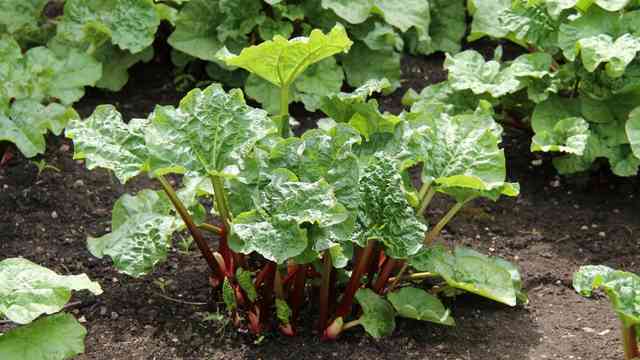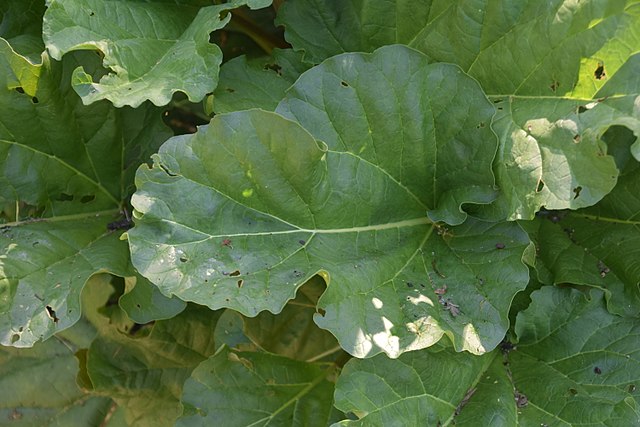Rhubarb is a delicious and versatile fruit used in pies, jams, and crumbles! Growing rhubarb is relatively easy and only requires a few simple supplies. With patience, you can have fresh rhubarb to enjoy all season long!
Rhubarb can be grown from crowns as well as from seeds. Gardeners prefer to grow rhubarb from crowns because it takes less effort and time to get a good harvest.
If you have a lot of money and time on your hands and you are interested in a substantial rhubarb farming operation, then you can start by planting rhubarb from seeds.
However, In this article, we will discuss different aspects of how to grow rhubarb from a crown.
Basic Requirements For Growing Rhubarb

The primary requirement is to buy a crown that’s a bit bulky and has a clear shoot coming out of it. Many gardeners make the mistake of choosing a crown that’s been dried out or sitting in the packet for a long time, making the shoot unsuitable for growth.
The weight of the rhubarb crown should be around 4-5 lbs. You should try to get it from the farmer’s market in February.
It is advisable to look carefully before purchasing the crown, as it will drain all your future efforts to get a bumper Rhubarb harvest.
You should also bear that rhubarb must not be grown in the vicinity of other perennial weeds. In some cases, the planting site might have some weeds growing around. Eliminate them before planting rhubarb.
Recommended – 9 Weeds That Look Like Rhubarb (and how to tell them apart)
Transplanting fully-grown rhubarb can be a little tricky. Therefore, choose your spot carefully before planting.
Where is The Best Place to Plant Rhubarb?
You should plant rhubarb in a sunny spot with fertile, well-drained, and slightly acidic soil. Rhubarb will not do well in areas that are too wet or too dry. As plants can spread quickly, leave enough space between each one when planting.
How to Plant a Rhubarb Crown?

- You can start by digging a hole at least 25 inches deep with a diameter of 23 inches.
- Add 6 inches of compost and fill it with a mixture of well-drained soil and compost, leaving a depression for the crown.
- Plant the crown in the hole and cover the buds with an inch of soil.
- Rhubarb is known to be a heavy feeder; therefore, it is recommended to mulch it with either manure or a mixture of shredded leaves. Make sure that the center of the crown remains uncovered.
- Planting rhubarb in full sun is essential. You might need to shade rhubarb in areas with high temperatures during the summer.
Check out this video to learn more about How To Grow Rhubarb From a Crown
How to Care For Rhubarb Plants
Rhubarb plants are well known for being effortless when it comes to caring. Make sure to keep the soil moist. You can feed it with an organic fertilizer during mid-summer.
Cut the flower stalks when they appear. During Autumn, dispose of the dead leaves and add three cms of new mulch on top of the crown.
You should remove the mulch in spring, dig in compost, and replace the mulch without disturbing the crown.
Harvesting Rhubarb

It is advisable not to harvest rhubarb in its first full growing season, which will help develop a robust root system.
Next year, take out a few stalks; you can harvest for up to 10 weeks after the 2nd year.
Make sure the rhubarb stalks are at least 30 centimeters long. You can twist the stem with your thumb and pull it off without taking the help of any tool or sharp object.
You should remember not to take all the stems off your Rhubarb plant and leave some little stems on it to get some good crops next year.
Dividing Rhubarb
Many gardeners with ample space like to multiply their existing Rhubarb plants by dividing the crown and replanting it.
You can start the procedure by dividing it in early spring before the shoots start propping up.
Cut the large side roots off the crown after digging it up.
You can divide the crown into multiple pieces with roots and a couple of buds on it.
Pests and Diseases

Rhubarb is quite strong enough to sustain the attacks of pests and diseases. Despite the plant being healthy all year, you must look for some pests that can attack the plant.
Rhubarb Curculio is a pest that attacks the plant by laying eggs inside the stalk. You can remove the pests by handpicking them, or you can use an insecticide as well.
Crown rot is a disease affecting the rhubarb plant’s crown and roots. There’s no solution or cure for this problem other than dispatching the affected crop and planting new crowns on fertile, well-drained land. Make sure that the soil surface is appropriate for the plant to thrive.
Anthracnose disease impacts the leaves and stalks of the rhubarb plant. The watery spots signify the beginning of this disease which can eventually lead to dead leaves and a weak rhubarb plant.
You can control it by spraying any sulfur-based spray as soon as the spots are visible. Repeat this process every week to ward off the disease.
You might have to remove the plant if the spots are visible even after applying this procedure for a whole month.
Rhubarb Varieties
Wandin Red – The Wandin Red rhubarb variety is characterized by its deep red color and sweet flavor. This variety is also exceptionally resistant to disease and pests, making it an excellent choice for growers.
MacDonald – MacDonald rhubarb is a plant grown for its thick, red stalks. The stalks are used in pies, jams, and other desserts. This variety of rhubarb is named after John MacDonald, who developed it in the early 1900s.
One of the things that makes MacDonald rhubarb special is its color. The stalks are a deep red, almost purple color.
Stockbridge Arrow – It is grown for its thick, fleshy stalks. The stalks are typically red or green and have a sour taste.
Giant Victoria – This variety is known to be much larger than other types of rhubarb. The giant Victoria rhubarb can grow up to six feet tall and three feet wide. The leaves of the giant Victoria rhubarb are also much bigger than other types of rhubarb, and they are a deep green color. The stalks of the giant Victoria rhubarb are pink, and they are very thick.
Red Dragon – Red dragon rhubarb is a plant with big, green leaves and red stems. The red dragon part of its name comes from the fact that the stems are long – up to 3 feet! They have lots of little bumps on them that look like scales. When you cut open a stem, it’s filled with a white, milky substance. This plant is native to China, but you can also find it in other parts of Asia.





[…] Rhubarb is commonly found in the gardens of North American and European regions. People often mistake Rhubarb with its other varieties that are strikingly similar in features. Consuming some of these varieties can be very harmful to your health. […]
[…] from crowns is known to be ideal for rhubarb farming. It is inexpensive and saves time and effort. However, […]